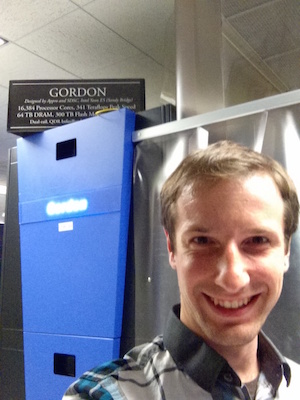 What would you do with 2 petaflops of processing power? It’s not an idle question: NSF’s XSEDE infrastructure offers researchers access to large-scale computing resources. I spent the last week at the San Diego Supercomputer Center, which hosts an annual Summer Institute to introduce scientists from many disciplines to high-performance computing technologies. Tissue engineering doesn’t have a lot of petascale problems but I did learn a lot about tools that can help me write more performant code on single and multi-processor systems—even in Python, my favorite programming language. ~And~ I got to take a selfie with a supercomputer.
What would you do with 2 petaflops of processing power? It’s not an idle question: NSF’s XSEDE infrastructure offers researchers access to large-scale computing resources. I spent the last week at the San Diego Supercomputer Center, which hosts an annual Summer Institute to introduce scientists from many disciplines to high-performance computing technologies. Tissue engineering doesn’t have a lot of petascale problems but I did learn a lot about tools that can help me write more performant code on single and multi-processor systems—even in Python, my favorite programming language. ~And~ I got to take a selfie with a supercomputer.
Continue reading
I needed an accurate and inexpensive temperature logger to calibrate our stage incubator for live cell microscopy and make sure that it was stable over time, so I built one. This was a very quick project, using a $30 Dataq DI-145 data logger and a $4 epoxy-coated thermistor from Adafruit. (To power the thermistor from USB, which is safe and easy, add a micro-USB breakout board, a matching USB cable, and a small solderless breadboard for the complete package!)
Continue reading
Here are the incantations you need to perform to create a Cairo surface from a grayscale image in a Numpy array, doodle on it, and convert the doodled-upon image back into a Pillow image so you can save it as e.g. a JPEG.
Comments
I'm starting a list of nice bike loops around UCI, for "beginning to medium" cyclists like me. No gratuitous hills in there yet, but maybe I'll get bored of flat roads eventually!
Comments
Here’s what’s on my ballot for anything that isn’t municipal or judicial.
Continue reading